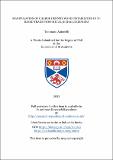Files in this item
Manipulation of charge density wave instabilities in Ti-based transition-metal dichalcogenides
Item metadata
| dc.contributor.advisor | King, Phil | |
| dc.contributor.author | Antonelli, Tommaso | |
| dc.coverage.spatial | xi, 136 p. | en_US |
| dc.date.accessioned | 2023-01-04T16:58:52Z | |
| dc.date.available | 2023-01-04T16:58:52Z | |
| dc.date.issued | 2023-06-12 | |
| dc.identifier.uri | https://hdl.handle.net/10023/26672 | |
| dc.description.abstract | Transition metal dichalcogenides (TMDs) offer a versatile platform to study the interplay of different electronic interactions underpinning collective quantum phases such as ferromagnetism, superconductivity and charge density waves (CDW). In particular, TiSe₂ shows an anomalous CDW instability whose microscopic nature has been debated for ∼50 years, but it still remains unclear. A similar phase transition has been recently observed in single layer TiTe₂, but not in the multilayer system opening further controversy on the origin of such lattice instability. In this thesis, I explore different experimental methods for manipulating the CDW transition in TiX₂ (X = Se, Te) by means of molecular beam epitaxy and angle resolved photoemission spectroscopy (ARPES). I report an in-depth photoemission study of the anomalous lattice instability in single layer TiTe₂ providing the first evidence of an electronic energy gain driving the CDW phase in the monolayer configuration. The experimental results are rationalised in a minimal model that ultimately gives a natural explanation for the unusual dimensionality crossover of the CDW instability in TiTe₂. By chemically substituting Te with Se, 2D ML-TiTe₂ₓSe₂₍₁₋ₓ₎ alloys are synthesised for the first time, showing a semiconductor (x = 0) to semimetal (x = 1) transition in the normal phase. The ARPES analysis reported here reveals the continuous evolution of the CDW instability across the entire alloy series opening a new route to manipulate this collective phase at the 2D limit. As an alternative approach, I explore the role of remote electronic screening in manipulating the CDW order in ML-TiSe₂. A V₂O₃ functional substrate able to switch between metallic (high screening) to insulating (low screening) phase is used for this purpose, although further optimisations are needed to improve the crystal quality of ML-TiSe₂ deposited on top. This work brings critical new insights for the understanding of CDW-like states across the family of group-VI TMDs and to engineer collective electronic states in 2D materials. | en_US |
| dc.language.iso | en | en_US |
| dc.relation | Manipulation of charge density wave instabilities in Ti-based transition-metal dichalcogenides (thesis data) Antonelli, T., University of St Andrews, 27 Feb 2024. DOI: https://doi.org/10.17630/0191a34b-4d99-4855-af97-6d67894fabee | en |
| dc.relation.uri | https://doi.org/10.17630/0191a34b-4d99-4855-af97-6d67894fabee | |
| dc.subject.lcc | QC173.454A68 | en |
| dc.title | Manipulation of charge density wave instabilities in Ti-based transition-metal dichalcogenides | en_US |
| dc.type | Thesis | en_US |
| dc.contributor.sponsor | Leverhulme Trust | en_US |
| dc.type.qualificationlevel | Doctoral | en_US |
| dc.type.qualificationname | PhD Doctor of Philosophy | en_US |
| dc.publisher.institution | The University of St Andrews | en_US |
| dc.rights.embargoreason | Embargo period has ended, thesis made available in accordance with University regulations | en |
| dc.identifier.doi | https://doi.org/10.17630/sta/241 |
This item appears in the following Collection(s)
Items in the St Andrews Research Repository are protected by copyright, with all rights reserved, unless otherwise indicated.

